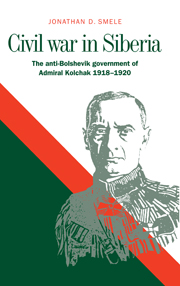Book contents
- Frontmatter
- Contents
- List of maps
- Preface
- Glossary and abbreviations
- Maps
- Introduction
- 1 The triumphal march of reaction
- 2 The establishment of the Kolchak Government
- 3 ‘What Kolchak Wants!’: military versus polity in White Siberia
- 4 Inside Kolchakia: from ‘a land of milk and honey’ to ‘the dictatorship of the whip’
- 5 White débâcle
- 6 White agony
- Conclusion
- Appendix The Anti-Bolshevik Governments in Siberia, 1918–1920
- Bibliography
- Index
4 - Inside Kolchakia: from ‘a land of milk and honey’ to ‘the dictatorship of the whip’
Published online by Cambridge University Press: 03 November 2009
- Frontmatter
- Contents
- List of maps
- Preface
- Glossary and abbreviations
- Maps
- Introduction
- 1 The triumphal march of reaction
- 2 The establishment of the Kolchak Government
- 3 ‘What Kolchak Wants!’: military versus polity in White Siberia
- 4 Inside Kolchakia: from ‘a land of milk and honey’ to ‘the dictatorship of the whip’
- 5 White débâcle
- 6 White agony
- Conclusion
- Appendix The Anti-Bolshevik Governments in Siberia, 1918–1920
- Bibliography
- Index
Summary
Travelling westwards along the Trans-Siberian Railway on a Foreign Office intelligence-gathering mission in April 1919, the British historian Bernard Pares perceptively remarked that, in the absence of the sort of patriotic fervour which a national war might engender, in the Russian Civil War ‘to the average citizen politics is becoming more economics than anything else’. It might, in fact, be argued that the average Russian citizen–a peasant, at best semi-literate–had never been attracted to abstract notions of democracy and political reform: the State Duma, the zemstvos and the Constituent Assembly were the totems only of the intelligentsia and of liberal elements of the bureaucracy. But certainly by 1919, as Pares implied, popular support was likely to be won or lost as a result of what the contending régimes in Russia could offer not tomorrow, in some socialist, monarchist or liberal-democratic utopia, but today, in terms of hard goods, hard cash and economic stability.
This was particularly true in Siberia. It was, after all, a region with a population which was not renowned for political activism, compared even with the rest of what had until recently been termed ‘slumbering Russia’. Of course, White elements had been attracted to the east by the fact that Siberia was far from being a natural seedbed of Bolshevism in terms of demography, consisting as it did of only a smattering of unorganized and disunited workers dissolved in the mass of a prosperous free peasantry. And, at least initially, their hopes had been realized.
- Type
- Chapter
- Information
- Civil War in SiberiaThe Anti-Bolshevik Government of Admiral Kolchak, 1918–1920, pp. 327 - 471Publisher: Cambridge University PressPrint publication year: 1997



